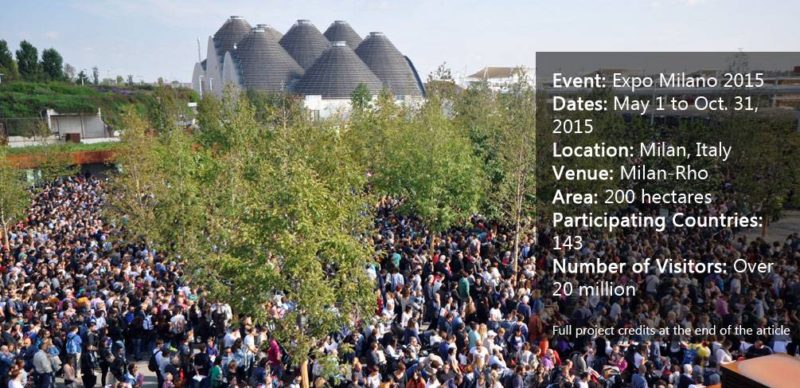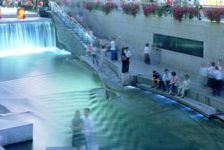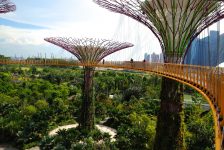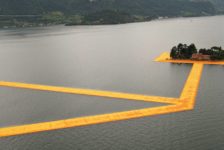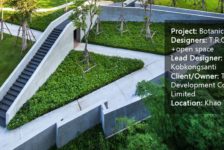LAN’s Brett Lezon and Win Phyo went to Expo Milano 2015 and compiled a list of 10 Highlights that stand out for Landscape Architects. Dating back to 1851, in London, the Universal Exhibition has served as the stage for showcasing the world’s successes. From the phonograph (1878 Paris World Expo) to electricity (1904 St. Louis World’s Fair), endless inventions have made their first appearance at World Expos. Based in Milan, the economic and cultural capital of Italy, Expo Milano 2015 took place from May 1 to Oct. 31 and featured pavilions from 143 participating countries, representing 93 percent of the global population. Open and inclusive, beautiful and ambitious: Bringing the world to Milan for six months was certainly an impressive challenge, and the organizers succeeded — more than 20 million people visited the Expo. Titled “Feeding the Planet, Energy for Life”, the Expo observed traditional food production, shared cultural values, and explored the implementation of new technologies. We had the opportunity to attend in mid-October and witnessed a number of concepts that landscape architects could employ on many different scales. Whether your next project aspires to be quirky, productive, or simply experiential, take a look at our Top 10 takeaways for Landscape Architects.
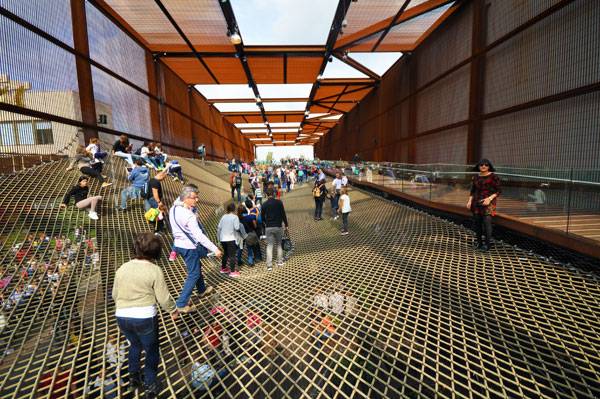
Brazillian Pavilion. Photo credit: Win Phyo
Highlights From Expo Milano
1. Large-Scale Event Master Planning
Designed by Stefano Boeri, Richard Burdett, Mark Rylander, Jacques Herzog, and William McDonough, the site covered an area of 290 hectares (490 acres) and was readily accessible by several modes of transportation. Interestingly enough, the site was harmonically organized by two wide avenues: “Decumanus” and “Cardo”. Decumanus stretched for 1 kilometer (0.62 miles) along the east-west axis and was dedicated to participating countries who presented their riches in terms of food and production. WATCH: Expo Milan 2015 The “Cardo” extended along the north-south axis and was assigned to Italy and its regions. This grid-system planning style was popularized by the ancient Romans to transport massive crowds. The master plan was not just a collection of large buildings, but a complex landscape — the impressive exposition garden included more than 12,000 trees, stunning water features, and a canal.
2. Details Matter
Even at a gigantic scale, the little details were not neglected. The repurposed wood sourced from the original Coney Island boardwalk in Brooklyn at the United States pavilion and the 17,000-piece, carefully assembled Japanese pavilion that allowed sunlight to pass through were just a few of the many crafty designs…. WATCH: Biodynamic cement for the Italian Pavilion at Expo 2015 – Press Conference …Not to mention the intricate latticework of the air-cleaning façade at the Italian pavilion, which was made from bespoke smog-purifying concrete by material manufacturer Italcementi. Is this perhaps the technology of the future?
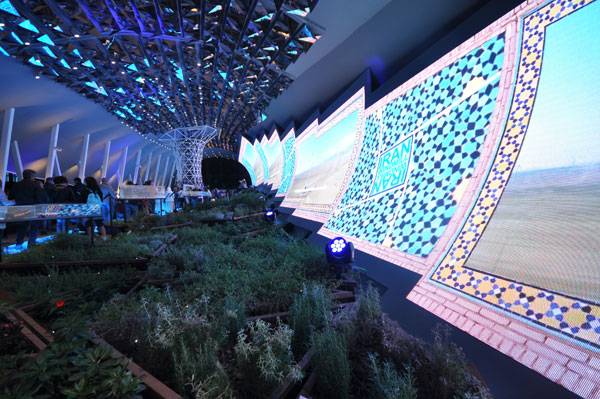
Intricate Latticework of the Iran Pavilion. Photo credit: Win Phyo
3. Porous Solutions
The United Arab Emirates pavilion, designed by Foster + Partners, creatively mimicked the narrow streets of an early desert city through the use of resin-bound surfacing — mostly locally sourced in Italy. The result was a porous, unified surface that delivered an undulating, sandscape feel.
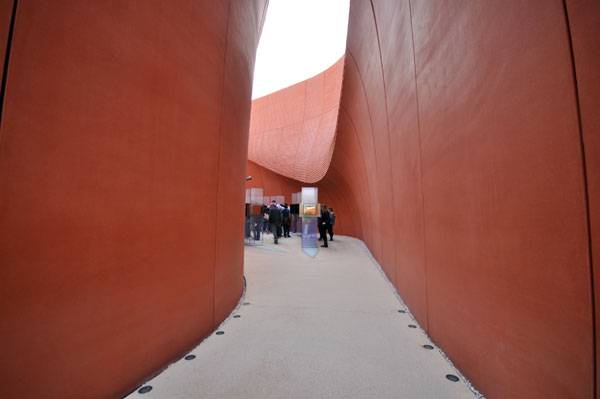
The Striking Simplicity of the Surfacing at the UAE Pavilion. Photo credit: Win Phyo
4. Innovative Mapping Conventions
At 290 hectares (490 acres), it was rather easy to become overwhelmed while traversing the Expo. However, a sleek mapping style dramatically simplified the way-finding process.
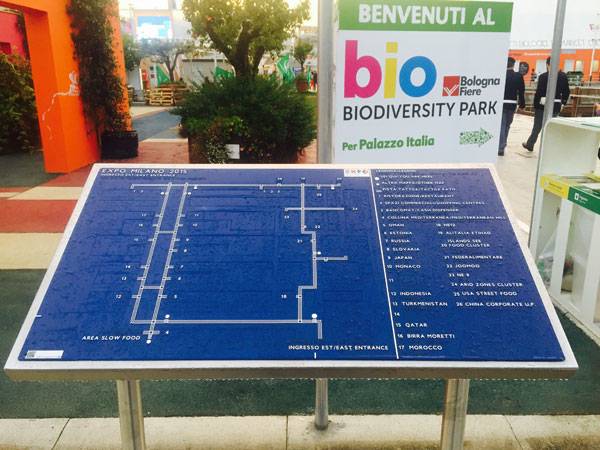
Expo Milano 2015 Sectional Map. Photo credit: Brett Lezon
5. Whimsical Seating Elements
Seating should never be repetitive at the World’s Fair, and Lithuania’s teeter-totter benches and Estonia’s kinetic energy swings were the most adventurous we encountered. The kinetic energy swings gave users a sense of how much energy is required for basic tasks such as charging a phone. We strolled past a group of wildly spinning children having fun on the British designer Thomas Heatherwick’s infamous Spun armchair. WATCH: Expo 2015: Estonian Pavilion The seats were arranged in the Lake Arena setting, where the most important installation of the exhibition — the “Tree of Life” — stands. Who would have thought this creation would be shown iconically in the most-visited and prestigious location of the Milan Expo 2015?
6. Out of the Box Uniqueness
The Brazilian pavilion had to be the quirkiest representation of a plaza or an outdoor space. Redefining the given space and created as a light and open structure that supports nothing but a huge trampoline net, the Brazilian pavilion is a plaza that welcomes people into its unique area. We clambered our way through and tried to keep our balance! Seriously speaking, the project shows how a space built with very few resources can provide such a memorable interaction.

Brazillian Pavilion. Photo credit: Win Phyo
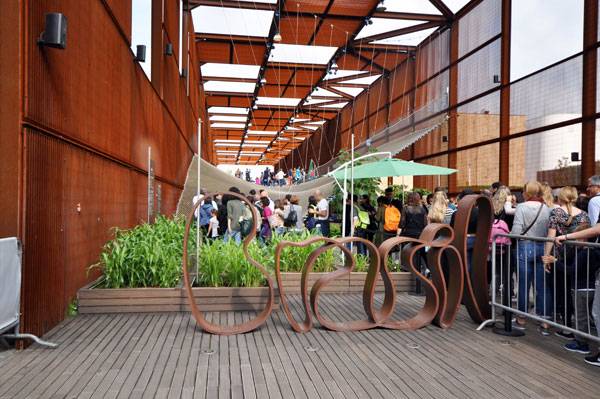
The Trampoline Awaits at the Brazilian Pavilion. Photo credit: Win Phyo
7. Biodiversity Park Was a Plant Lover’s Dream
Consisting of 0.85 hectares (2.10 acres), Biodiversity Park raised awareness of Italy’s environmental, agricultural, and food production qualities. We strolled the sweeping landscapes to observe different examples of organic farming styles from the major eco-regions of Italy. See More Cool Projects From Italy:
- Mediterranean Terrace Provides Inspired Living in Italy
- Historical Square Gets a Shocking Makeover!
- 15 Great Examples of Historical Landscape Architecture
The park had a strong narrative power: We discovered the riches of the Italian natural environment and its biodiversity. Boasting more than 300 species of plants, Biodiversity Park proved that the Italian organic farming methods serve as a global model. WATCH: Welcome to the Biodiversity Park in Expo Milano 2015
8. Lighting Counts
Proper lighting can add another dimension to any setting, and this was most certainly true for the Italian, United Kingdom, and Kuwait pavilions. While impressive by day, these pavilions were stunning at night. The cuboid lattice form known as the “hive”, which was the centerpiece of the UK pavilion, was designed by Wolfgang Buttress. It glowed based on activity from a real beehive.
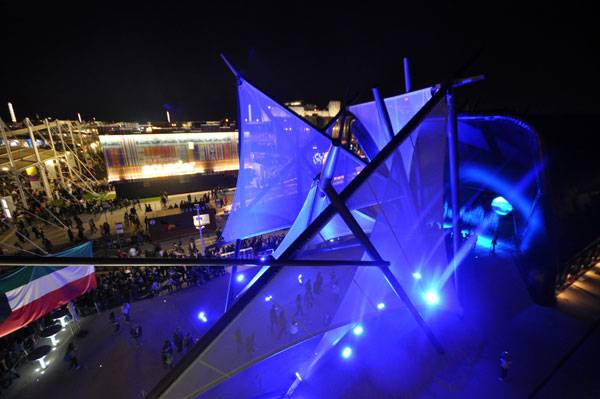
Stunning Lighting Display at the Kuwait Pavilion. Photo credit: Win Phyo
9. Design for the Experience
What’s a World’s Fair void of an enjoyable experience? The luna park-like festival grounds of the Holland pavilion was one of the most unique of all. It was furnished with a greenhouse, the world’s only Ferris wheel restaurant, nine food trucks, and Dutch DJs spinning the hottest dance tracks. What’s not to love about this incredible ambience? WATCH: Expo 2015: The Netherlands Pavilion
10. Vertical Farming
In the next 35 years, the world’s population is expected to grow from about 7 billion to 9 billion people. Many experts believe that vertical farming presents a solution to growing plants when maintaining a large tract of land is unattainable. We were impressed with the 860-square-meter (9,250-square-foot) automated vertical farm at the United States pavilion, which featured ZipGrow towers that are scalable, maximizing output in limited space.

Automated Vertical Farm at the USA Pavilion. Photo credit: Brett Lezon
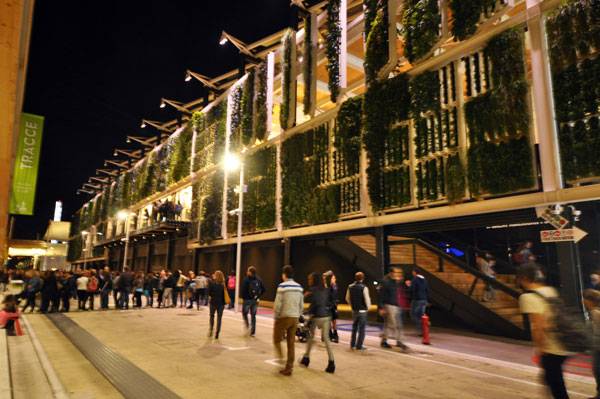
Nighttime Capture of the Automated Vertical Farm at the USA Pavilion. Photo credit: Win Phyo

Expo Milano 2015. Photo credit: Brett Lezon


